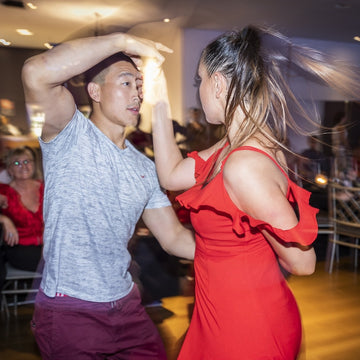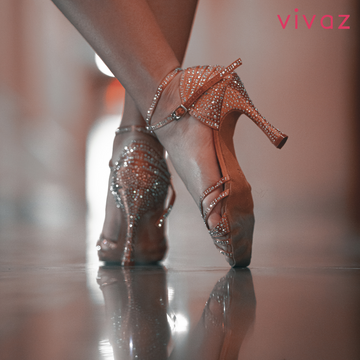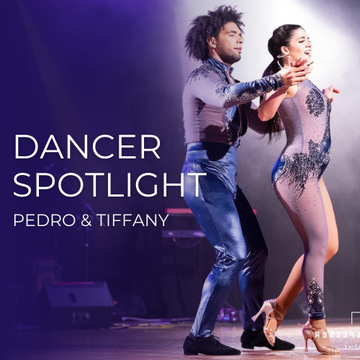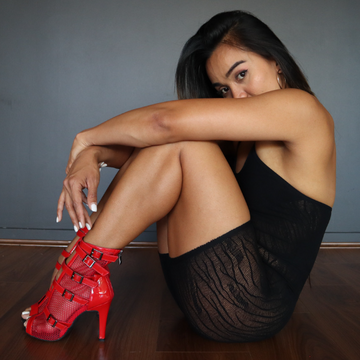
Learning how to dance is like learning how to play an instrument...Taking classes is greatly beneficial and will teach you almost everything you need to know, but it’s also important to get experience and practice as much as possible outside of class too. When learning an instrument, progress is slow if you do not practice outside of your lessons to maintain your skills, make mistakes and learn from them, and therefore gain confidence in yourself. Social dancing is the same as it provides you with opportunities to get out of your comfort zone, put the skills you’ve obtained from lessons to use, and feel more at ease the more you do it. The concept might sound frightening at first as a beginner, but by challenging yourself you will build confidence in yourself and your dancing. You just have to take that leap of faith.
You might have a personal reason for wanting to begin social dancing, such as improving your confidence, wanting to engage in the social scene again, or distract yourself and work through something you’re struggling with; so don’t postpone and tell yourself you’ll start tomorrow. Just start. A lot of people will tell themselves they'll go social dancing once they've gotten better, and because of this they never end up going. In order to help you, we’ve compiled a few tips to cast your worries away so once you’ve had a read, take a deep breath, strap on those dancing shoes, and get out there!
TIP 1: DON’T WORRY WHAT PEOPLE ARE THINKING. Everyone is there to improve their dancing and so are you. This is a chance for you to put those skills you've learned to use. Be patient with yourself, mistakes happen to everyone including professionals. If you make a mistake, don’t fixate, just keep going. It’s natural to feel nervous and have your doubts, but try to cast them aside and don’t let them hinder your improvement. You won’t be the only beginner and everyone there will realize you’re all at different levels, so there’s no reason to be self-conscious. Mistakes will happen, as they do for everyone, but that’s part of the process. You can’t learn without making mistakes, so continue practicing and learning from every partner you dance with. Each and every person starts as a beginner, so even the more advanced dancers will be understanding of any fumbles. Keep at it because the more you continue, the more confidence you will develop in yourself and the more you’ll improve.
TIP 2: MAKE SURE YOU HAVE A PAIR OF DANCE SHOES THAT ARE RIGHT FOR YOU. You want to feel comfortable on the dancefloor, so come wearing a pair of shoes that are the correct fit for your foot, the right height and heel type depending on what level of experience you have, as well as the perfect amount of support. If you’re a beginner then opt for a smaller, wider/flared heel because this will provide more stability. Shoes that are closed or have more straps will also provide extra support. As you improve you can choose open, less strappy heels with higher, slimmer heels when you feel confident you would be able to dance with the added height in shoes with alternative styles. Being comfortable will allow you to feel more at ease and be able to enjoy yourself even more. You should be focused on what your feet and your body are doing, not worrying about what you’re wearing. For some options, head over to the Vivaz Dance website and check out some of our most popular social dancing shoes.
TIP 3: THERE’S NOTHING WRONG WITH GOING ALONE. If you are able to bring friends dancing with you, that’s great, however if you are unable to then that is completely fine too. The primary focus of social dancing is the dancing itself and improvement. By coming alone you might even be encouraged to do better without anyone to distract you. You’ll probably end up dancing with a wide variety of people, so you might even make a friend while you’re there. There’s no need to feel awkward about flying solo since a majority of social dance goers come on their own and meet people through the experience, whereas coming with your own group encourages you to remain with them rather than engage with strangers. This will then also encourage you to stay in your comfort zone too, which will limit your progress. Make your priority improving your dancing, and if you meet anyone while you’re there then that’s an added bonus.
TIP 4: DANCE WITH AS MANY DIFFERENT PEOPLE AS YOU CAN. In this way you will learn a wider variety of things and be able to adapt to different levels of dancing. Say yes to every opportunity you get unlessyou would rather watch for a little while or need to take a bathroom break. If someone looks like they dance at a higher level and that worries you, just let them know where you are at. It is common for people of all levels to dance with one another, so don’t concern yourself if you don’t think you’re equally matched. Dancing with other beginners will feel more comfortable, but challenging yourself to dance with people who have been dancing longer will help you advance faster.
TIP 5: BE MINDFUL OF THE PEOPLE AROUND YOU AND YOUR SURROUNDINGS. Social dancing spaces can get busy and it's easy to get caught up in the moment, so try to keep your eyes peeled! Leads, do not dip or throw your follows into a turn without first checking if this can be done safely.
TIP 6: REFRAIN FROM POINTING OUT MISTAKES. Your reason for starting social dancing might differ to your partner’s, but at the end of the day everyone is there for the experience and the opportunity to improve their dancing or to maintain their dance level. You are there for yourself as is everyone else, so if anyone makes a mistake, try to avoid educating your partner on the dancefloor. Dance classes are the space for people to understand what mistakes they’re making and how to fix them, whereas social dancing is an opportunity to practice while having fun in a relaxed environment. If you’re a beginner then you might understand the nerves others might be feeling, and pointing out mistakes could make your partner feel awkward when you want them to be comfortable. The experience should be a positive, empowering one that encourages you to come back again, so dance on regardless of any mistakes. They’re all part of the experience.
TIP 7: CONNECT WITH YOUR PARTNER. Connection with your partner can enhance your social dancing experience, so try to smile and make eye contact with them every now and then. If you’re tense because you’re nervous, just remember that most other people are nervous too and smiling might actually help relieve some of that tension. Ultimately you want each dance to feel like a positive, enjoyable experience for both people involved. Your worries are perfectly understandable, however they shouldn’t cloud your enjoyment, especially since nobody is there to judge you and realizes you may have your worries. Smiling and connecting with your partner helps establish a connection that makes dancing together easier and more comfortable, especially for dances like salsa and bachata where connecting with your partner is important. By connecting with your partner you’ll be able to lead or follow better and therefore will be more in sync the more you engage.
TIP 8: TAKE DANCE CLASSES. Dance classes and social dancing complement one another, so if you’re able to, try to take some classes alongside social dancing. Classes will help you learn about following, leading, and how to maintain a good frame -- all skills you can then carry into social dancing. Social dancing is a learning experience in itself and you learn through dancing with partners at different levels, but in classes you’ll really be able to hone specific skills and ensure you’re learning the correct habits. While social dancing you rely on yourself to realize any mistakes you might possibly make since a respectful partner shouldn’t point them out, so having a professional let you know in class where you can improve will help you progress better, which in turn will make you feel more confident in your dancing and therefore your social dancing will simultaneously improve.
TIP 9: RESPECT BOUNDARIES. Even if you're dancing something sensual like bachata, be respectful and don't touch your partner where you shouldn't unless you are familiar with your partner and they are alright with you being slightly more forward. You want everyone to be comfortable so extend the same level of courtesy you would expect for yourself.
TIP 10: LIMIT DANGEROUS ACCESSORIES AND CLOTHING. Try to limit accessories and clothing that will swing around and hurt your partner. Long necklaces, scarves, or rings can potentially be dangerous or get caught on your partner mid-step, so consider what you wear first before hitting the dancefloor.
TIP 11: SHOW UP LOOKING AND FEELING YOUR BEST. When dancing you want to feel your best for yourself and your partner, so try to make sure to freshen up before you go dancing. Taking the time to make yourself presentable might seem superficial, but the more put together you feel, the more confident and at ease you will be. Your partner will be able to feel if you are at ease, which will in turn help you connect with them better and enjoy yourself more. Little things can give you a boost of confidence and are worth the extra time since they can provide a better experience for everyone involved.
TIP 12: PRACTICE AS MUCH AS POSSIBLE. As a beginner you will probably have trouble maintaining rhythm, which is normal, so in your free time try to listen to the genre of music you will be dancing to and count along to it in order to familiarize yourself with the timing.Don't worry if you have trouble gauging rhythm at first, you will improve as you go. The more you listen, the more in tune you will become with the music, and therefore your dancing. Dance styles like salsa and bachata are deeply rooted in the Latino community and are very passionate styles, so the more you relate to the music and its history, the better you’ll be able to loosen up. Dance lessons will also help you gain the knowledge you need about timing and foundation steps, which you can then practice at home to maintain the skills you have learned. Practice your steps and slides while brushing your teeth, waiting for pasta to boil, in the morning to wake yourself up -- dance at any opportunity you get.
Go in armed with these tips, but also remember to breathe, relax, and have fun! Those nerves will pass, just make sure to get yourself out there and dancing. Check out the Vivaz Dance website to find yourself the right pair of dance shoes, and then stop putting it off! You’ll find your worries subsiding the more you practice and wonder why you didn’t start sooner! With time you will get better, but until then just remember to learn from whatever mistakes you might make without letting them get to your head, be patient with yourself and others, and have a wonderful time!
-Written for Vivaz Dance by Christine Church







